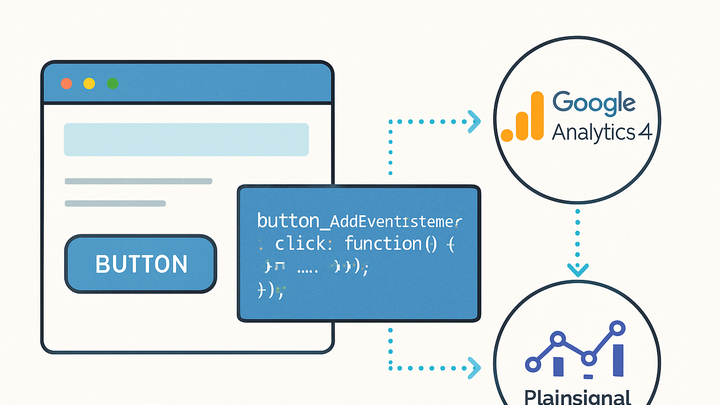Published on 2025-06-22T07:40:43Z
What is an Event Listener? Examples in GA4 and PlainSignal
An event listener in the analytics context is a small piece of JavaScript code that waits for specific user or system actions on a web page and then executes a callback function whenever such actions occur. These user interactions might include clicks, form submissions, scrolling, video plays, or any custom events defined by developers. By leveraging event listeners, analytics platforms can capture detailed, granular data about how users engage with content. In modern analytics solutions like Google Analytics 4 (GA4) and PlainSignal, event listeners are integral to the event-based data collection model, ensuring that each interaction is recorded as a structured event. This approach replaces older pageview-centric tracking by focusing on actions that matter for behavioral analysis. Proper implementation of event listeners leads to more accurate insights into conversion funnels, feature usage, and user behavior patterns. Without reliable event listeners, analytics data can suffer from gaps, duplication, or inaccuracies.
Event listener
A JavaScript function that monitors user actions (clicks, submits, scrolls) and triggers analytics events in GA4 and PlainSignal.
Understanding Event Listeners
Event listeners are the building blocks of interactive analytics. They let your code watch for specific events—like clicks, form submissions, or custom signals—and run a callback whenever those events fire.
-
Definition
An event listener is a function or routine registered on a target (like a DOM element) that waits for a specified event type, then invokes a callback when the event occurs.
-
Components of an event listener
Every event listener consists of three core parts:
-
Event type
The kind of interaction to watch for, such as ‘click’, ‘scroll’, ‘submit’, or a custom event name.
-
Callback function
The code that runs in response to the event, typically sending data to an analytics endpoint.
-
Role in Web Analytics
In analytics, event listeners enable fine-grained tracking of user behavior beyond simple pageviews. They power data collection for any interaction you care about.
-
Capturing user interactions
Listeners detect user actions like button clicks, form submissions, media plays, or custom events, then package and send that data to analytics platforms.
-
Integration with data layers
Event listeners often push structured data into a data layer or directly invoke SDK calls.
-
Data layer
A global JavaScript object (e.g., window.dataLayer) that aggregates events for tools like Google Tag Manager.
-
Sdk calls
Direct function calls (e.g., PlainSignal.track() or gtag(‘event’, …)) made within the callback to send data immediately.
-
Implementing with GA4
Google Analytics 4 relies entirely on event-based tracking. You can send events via the gtag.js library or through Google Tag Manager triggers.
-
Using gtag.js
Embed gtag.js in your page and call gtag(‘event’, …) inside your listener callbacks.
-
Basic syntax
gtag(‘event’, ‘event_name’, { ‘event_category’: ‘category’, ‘event_label’: ‘label’ });
-
Attaching to dom
Add a JS event listener to an element, then invoke gtag() within that callback to record the interaction.
-
-
Using google tag manager
Configure auto-event triggers or custom tags in GTM to fire on clicks, form submissions, or other events without touching page code.
Implementing with PlainSignal
PlainSignal is a lightweight, cookie-free analytics solution. You install a small snippet and then use event listeners to send custom events.
-
Installation and setup
Add the PlainSignal snippet to your HTML <head>:
<link rel='preconnect' href='//eu.plainsignal.com/' crossorigin /> <script defer data-do='yourwebsitedomain.com' data-id='0GQV1xmtzQQ' data-api='//eu.plainsignal.com' src='//cdn.plainsignal.com/plainsignal-min.js'></script> -
Tracking custom events
After setup, attach JS listeners and call PlainSignal.track() in the callback:
document.getElementById('subscribe-btn').addEventListener('click', function() { PlainSignal.track('subscribe_click'); });
Best Practices and Common Pitfalls
To ensure accurate, performant analytics, follow these guidelines when using event listeners.
-
Debounce and throttle events
Limit how often high-frequency events fire to avoid performance hits and data noise.
-
Debouncing
Delay execution until a pause in activity—for example, only report scroll once the user stops scrolling.
-
Throttling
Ensure events fire no more than once in a set time interval to balance data granularity and overhead.
-
-
Avoiding duplicate tracking
Prevent the same event from sending multiple times due to duplicate listeners or page reloads.
-
Single listener
Attach one listener per element and track initialization states to avoid re-registering on repeated renders.
-
-
Handling dynamic elements
Use event delegation to track elements inserted after initial page load.
-
Event delegation
Attach to a stable parent container and inspect event.target to handle child elements dynamically.
-
